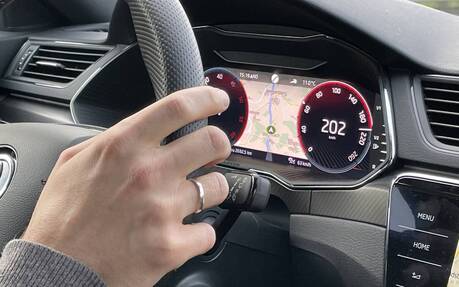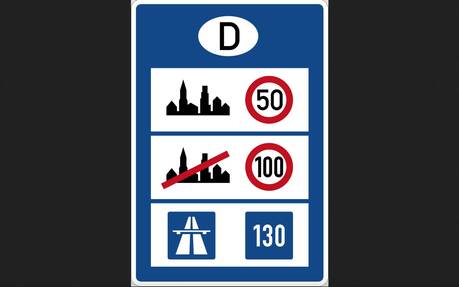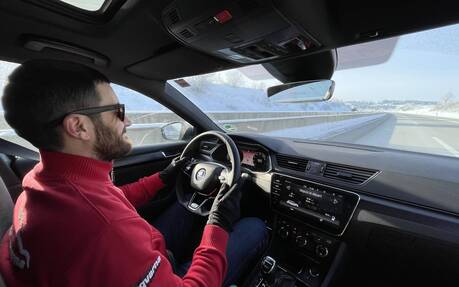5 Tips for Driving on the German Autobahn
German highways, or the famous autobahns, are what dream are made of for the car enthusiast. While almost all countries have speed limits on their roads and highways, Germany is an exception. In fact, many German highways have no speed limits. The Highway Code
recommends a speed limit of 130 km/h, but it is left to the driver to adapt his or her speed to the circumstances.
With a powerful car, it is therefore possible to drive at 150, 200 or 250 km/h without risking losing your licence. However, this privilege also comes with some responsibilities and it is important to remember that German highways are not race tracks.
- Also: The Autobahn Will Now Host Autonomous Vehicles
- Also: New Autonomous Driving Capabilities Coming to Mercedes-Benz Cars
The Car Guide team has often had the opportunity to drive on the Autobahn. If you're planning a trip to Germany, here are our tips to prevent your highway escapade from turning into a nightmare.
Limitless... but Not Everywhere
Entering the Autobahn doesn't mean you can immediately floor it. The sign that tells you that you can drive without limits is a white circle with five black stripes. You have to wait until you pass this sign before you can speed up.

Several sections are limited with fixed signs, especially in dangerous areas or on the approach to cities. The speed limit can also vary according to special circumstances, such as rain, snow or roadwork.
In some unlimited sections, you may see signs indicating 80, 100 or 120 km/h, with a white square with the words "bei Nässe", which can be translated as "if wet". This means that if it is raining or the road is wet, you have to slow down to the prescribed speed limit.

Except for a few delinquent drivers, the majority of users respect the speeds on the signs. We advise you to do the same, because the fines can be very high... If you drive at 200 km/h in a 120 km/h zone, the fine can go as high as 700 euros ($1,000) and you can be banned
from driving in Germany.
Look ahead... but also behind!
As your speed increases, your field of vision is reduced. This is compounded by the fact that you are travelling a greater distance than usual. At 120 km/h, your vehicle is travelling 33 metres per second. At 200 km/h, that number jumps to 55 metres per second! Therefore, it is essential that all your senses remain alert and that you are fully focused on your driving. Also, remember to increase your safety distance from the vehicles around you.
By the way, drivers usually brake hard when a speed limit comes up. That's another good reason to keep a good distance with the car in front of you. Don't forget that if you are driving at 200 km/h, you will also have to lose a lot of speed very quickly. So don't hesitate to press the brake pedal hard to lower your speed.
Conversely, if you want to pass someone, don't ride their behind. Germans never dawdle in the left lane, and will pull over as soon as they can. Wait a few seconds and the lane should clear quickly.
In Canada and the U.S., it is not uncommon to see a steady stream of vehicles in the left lane, with the right lane being almost empty. On the Autobahn, it's the opposite! The police can give you a ticket if you are in a left lane for no reason.
But beyond the fine, it is above all the danger that it represents. Even if you are driving at 190 or 200 km/h with your rental car, there could be a Porsche 911 Turbo coming up behind you at 260 km/h! So keep an eye on your mirrors... but not too much either, because you mustn't lose sight of what's going on in front. It's all about the right balance.

Keeping a Cool Head
Let's face it, going fast is fun. But it's crucial to keep your focus on the no-limit portions. This is a highway, not a race track. There are other users, trucks, motorcycles, etc. Just because you can drive fast doesn't mean you can do it constantly.
If the traffic is light, the weather is clear and the road is straight, take it easy and let the speed increase. Slow down if weather or traffic conditions do not permit. With a few exceptions, most road users moderate their speed if necessary, even on unlimited stretches of road.

It is also important to keep a speed that is appropriate for the capabilities of your vehicle and the road conditions. Not all cars have the same level of grip or dynamic capabilities. Going around a curve at 180 km/h with a subcompact car with narrow tires and steering that is numbed by speed isn't very safe. On the other hand, you can safely drive at 220 km/h in a sports car or a big powerful sedan.
Finally, if you have never driven at high speeds or are a young driver with little experience, we recommend that you increase your speed gradually, regardless of the vehicle you drive. Your safety and the safety of others is at stake.
In the event of an accident, if authorities determine that you were overspeeding considering the conditions, you could be held partially responsible.
Beware of fatigue
When you drive at 150 or 200 km/h for a certain period of time, your brain gets used to the environment, so much so that the impression of speed decreases. Yet, things are still happening at a high rate of speed.
And as the kilometres go by, fatigue can set in. This reduces reflexes and on an unlimited stretch of road it is not forgivable. Driving at very high speeds requires much more concentration and involvement than we are used to in Canada. Don't hesitate to take breaks or slow down if you feel your cognitive abilities are diminishing.
Also, beware of speed addiction when an unlimited stretch ends. If you have been going 220 km/h for several minutes, going back to 120 km/h or even 80 km/h will seem very slow. Keep an eye on your speed to avoid exceeding it unintentionally.
Another thing: the legal limit for blood alcohol concentration is 0.05 in Germany - which is lower than our 0.08 limit. But if you consider driving at high speeds, you should stick to water and soda for all the good reasons mentioned above.
Additional Details
- Your Canadian driver's licence allows you to drive in Germany for 6 months. An international licence is not required.
When renting your vehicle, make sure you have the proper insurance to be covered in case of problems. Especially if you choose a luxury or sporty model with a high value. - The German highway network is generally well paved, much better than in certain parts of Canada. However, there are areas where the asphalt is rough, and there are many more winding sections with blind curves, especially in the south of the country near the mountains. Even if the speed is theoretically unlimited, going over 200 km/h in these conditions is not very safe.
- When there is traffic, you should hang left if you are in the left lane and right in the opposite lane to create a safety corridor for emergency vehicles.
- Driving fast is expensive in Germany. Between 120 and 220 km/h, fuel consumption can double! At the time of writing, a litre of unleaded 95 gasoline costs about $2.30 to $2.50 and a litre of diesel costs between $2.60 and $2.90. Depending on the vehicle you choose, the distance you drive and your average speed, you should factor this into your vacation budget.
